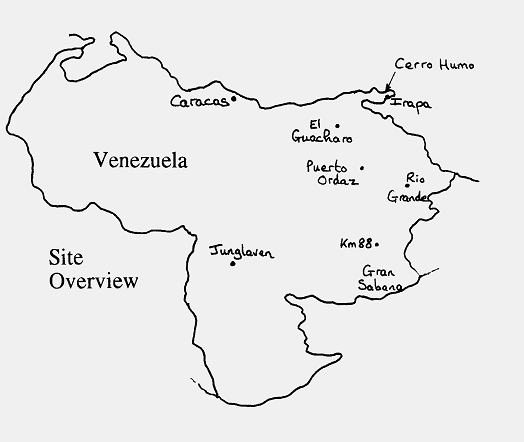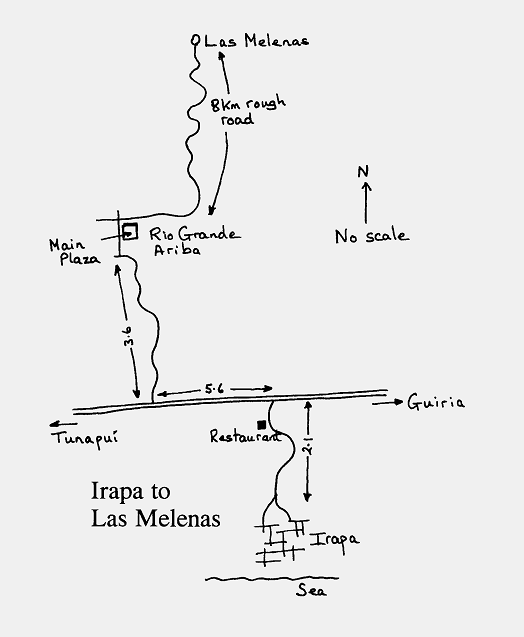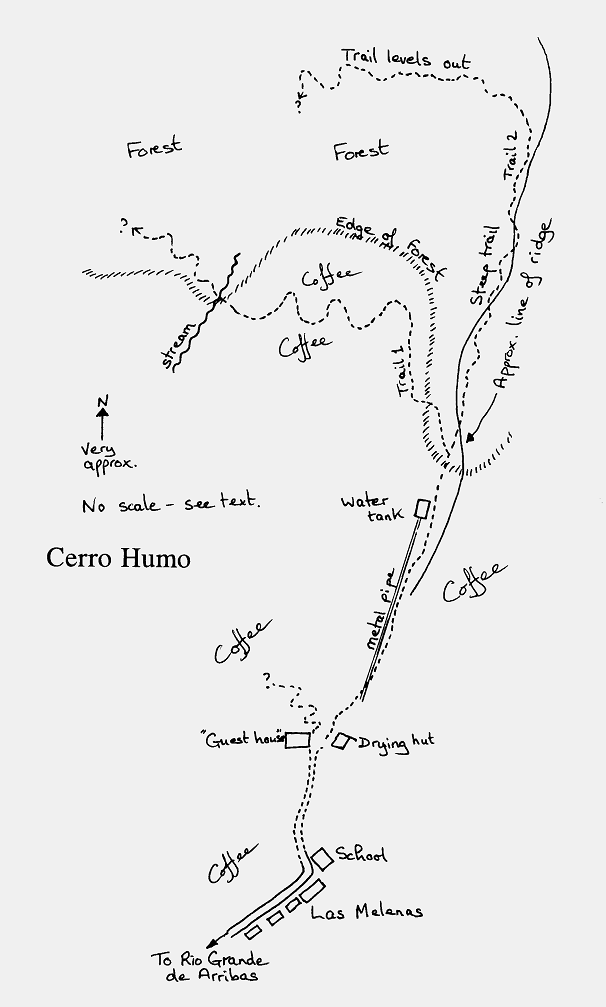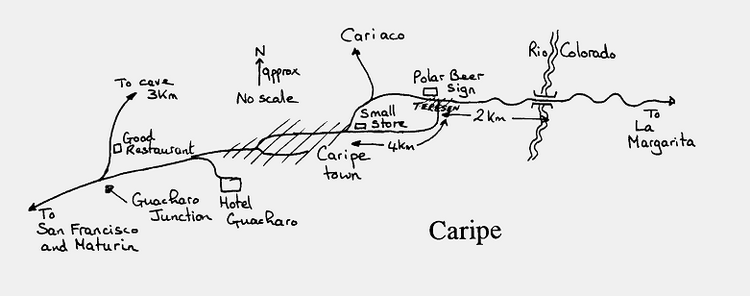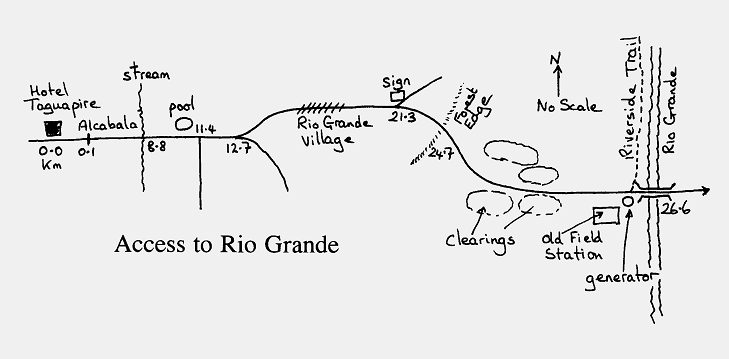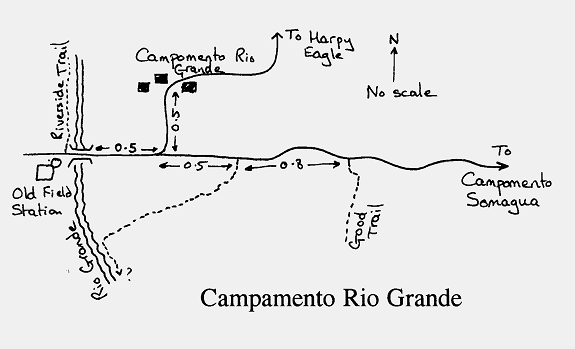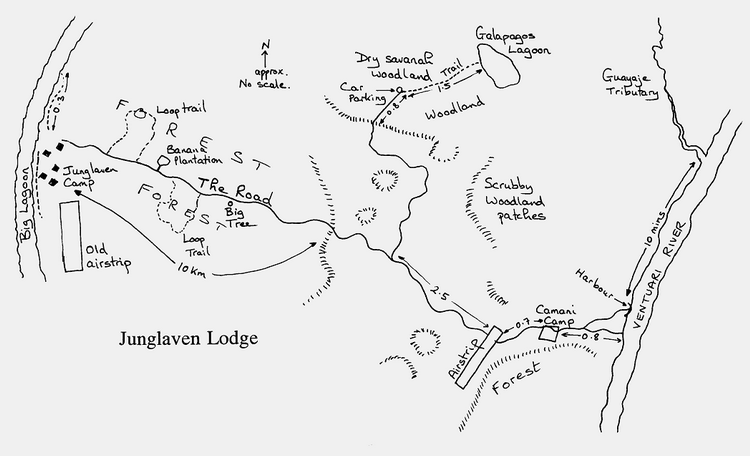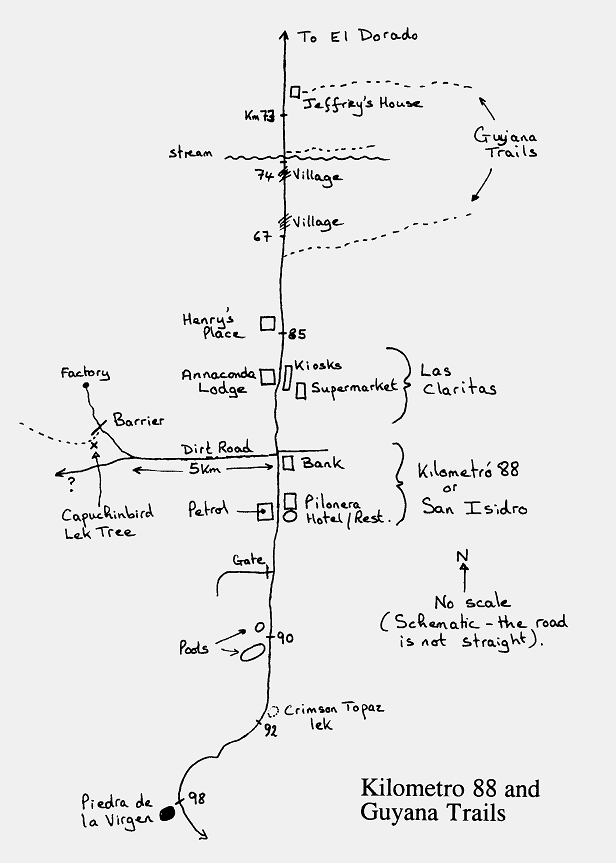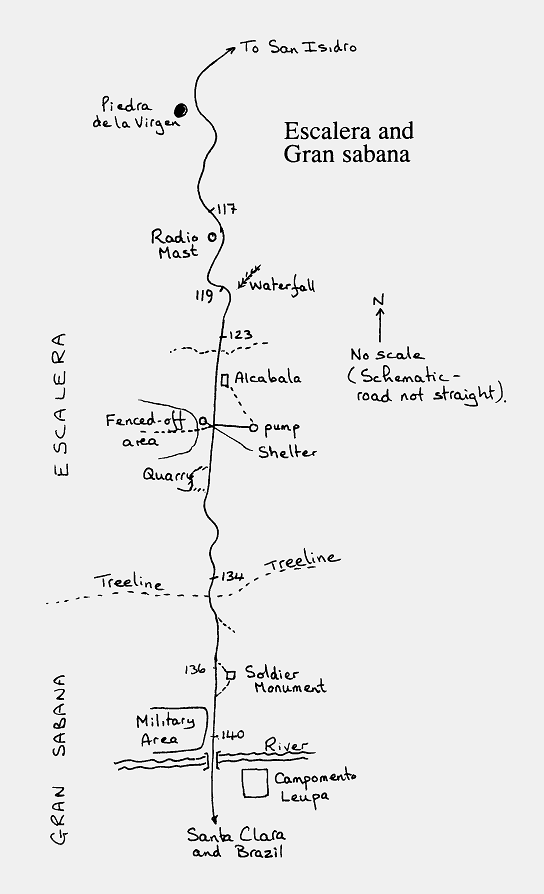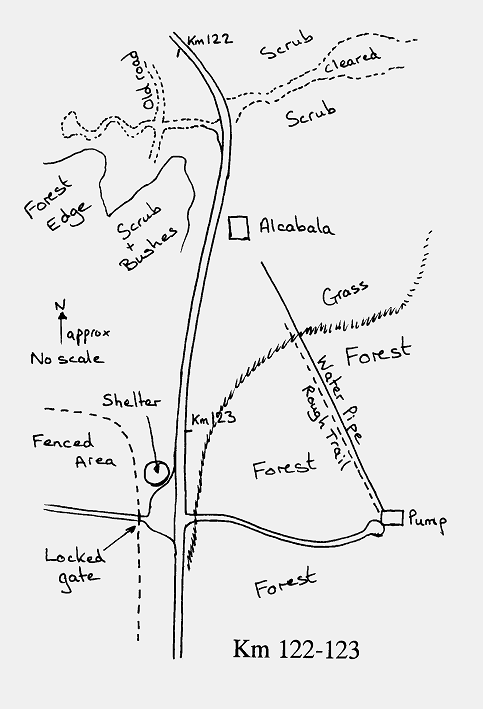Section 1 - Introduction, logistics, itinerary and general information.
Section 2 - Birding sites.
|
Birding SitesIncluded below are details of accommodation, access, habitat and a species list for each site. Although most are well known birding localities, I have tried to pull together personal and other available information into a comprehensive site overview. For most sites, the species lists include all species recorded from that site. Species which were personally seen/heard are indicated by the number seen/heard, or with a 'c' which denotes that the bird was common or fairly so. Species listed without number have been recorded at that site, but by other observers. |
Site V1. Avila National Park, Caracas
For those having to spend time near Caracas waiting for flights, a good option is to stay at Macuto, from which it is possible to walk/taxi to the Avila National Park. Close to the Hotels Macuto or Hidalgo, a road, called Via Galipan, ascends steeply into the forested hills above Macuto. There is usually a guard at the gate, where it may be necessary to show a passport.
Site V2. Ciudad Guyana (Puerto Ordaz)
En-route from the airport toward Maturin, between Puerto Ordaz airport and San Felix, a large area of rapids, together with a picnic area and zoo, are seen on the right side. A quick stop should find Black-collared Swallow on the exposed rocks in the river.
|
Site V3. Cerro Humo Cerro Humo (Smoke Mountain) lies at the eastern end of the Paria Peninsula in the extreme northeast of Venezuela. The area lies within the designated boundary of the Paria Peninsula National Park and is of interest to birders as it offers access to several Red Data Book birds largely restricted to the Paria peninsula - a few occur on Trinidad as well (see ICBP/IUCN Red Data Book). These species are White-tailed Sabrewing, Scissor-tailed Hummingbird, White-throated Barbtail, Yellow-faced Redstart, and Venezuelan Flower-piercer; all of which, except the flower-piercer, have been seen regularly on the mountain. Low cloud can be a problem, so several days, or a lot of luck, are required to see them all. Access is from the village of Las Melenas, north-west of the small coastal town of Irapa. The only reasonable accommodation is the Hotel Maryoli in the centre of Irapa. The hotel is basic and clean, but does not have food (nor beer!). |
Several small bars can be found in the town, but the only eating establishment which looks anything less than dodgy is the Turista restaurant on the right, just after turning off the main road into Irapa. We ate at this establishment on two evenings, and found it clean, and with electricity (for note writing) and ice-cold drinks. To get to Las Melenas from Irapa, return to the main road (2.1 km from the town centre), turn left (west), drive 5.6 km and then turn right (north) onto the dirt road to Rio Grande Arriba (a further 3.6 km). At Rio Grande Arriba, drive around the plaza (see map), to find the Las Melenas road. Las Melenas is about 10 km beyond Rio Grande Arriba. After Rio Grande Arriba the road deteriorates and becomes steeper. Some of the very steep sections have been concreted, and although we easily, but slowly, managed to get our two-wheel drive as far as Las Melenas, this might not be possible after heavy rain. For those without transport, hitching is possible, as a few vehicles with workers for the coffee plantations should pass in the early morning. Park at Las Melenas and walk down the wide dirt track (goes downhill) to the left of the school (see next map). After a few hundred metres this track dead-ends in a coffee plantation, at a newly constructed, though empty, "guest house" and a hut (for drying coffee or tobacco?).
|
|
Two trails start from here - one goes downhill behind the guest-house (nobody seems to explore this); the other runs up-hill, to the left of the small hut, and forms the main access to the forest and the endemics. We saw White-tailed Sabrewing around the guest house. Take the up-hill trail, which follows the edge of the coffee, and after a few hundred meters passes a low, concrete water tank. The water in the tank should be drinkable, as it apparently supplies the village. A small patch of forest is found just after the water tank, inside which the trail forks. The altitude here is about 3000 ft. Both forks should be explored. The left fork (Trail 1 on the map) passes to the left of the ridge, through forest edge and down through coffee plantations. The right fork (Trail 2 on the map) climbs more steeply, up into the cloud forest. Although the most productive trail appears to be Trail 1, which should be taken by those with less time, we saw the same endemic species along both trails.
Following Trail 1, it initially passes along the edge of the ridge with forest edge on the right and coffee plantations below, on the left. This ridge is probably the most reliable place for the Scissor-tailed Hummingbird. After a few hundred metres along the edge of the ridge, the trail descends steeply through the coffee, in which Yellow-faced Redstart and White-tailed Sabrewing can be found. At the bottom, the trail re-enters the forest and, shortly after, crosses a stream. Some birders have seen White-throated Barbtail in this area but we didn't. From here-on the trail starts to climb again through forest, and although some birders have reported that the trail dies-out quickly, we followed it for some way without problem. Where this trail leads I have no idea, but it could be possible that it loops around to form a continuous loop with Trial 2 (see map).
Trial 2 is almost wholly inside forest, though a few vistas over forest edge are presented during the first kilometre up-hill, which is steep and muddy. After this, it flattens out (at about 1.200 m.) and winds through pristine cloud forest, the trees laden with hanging moss, bromeliads and epiphites. This would seem to be absolutely perfect habitat for the White-throated Barbtail, which we failed to find due to insufficient time. All along this trail Slate-crowned Antpitta and Black-faced Antthrush are fairly common. After a further few hundred metres the trail descends, though we did not explore further. You need to take all your food and drink, as Las Melenas has no shop. The "guest house" has been reported to be a visitor's lodge, with the warden living at Las Melenas. However we saw nothing resembling anything official. At the start of the track to Las Melenas there is an Inparques office -possibly they can supply more information, and it may be possible to stay in the guesthouse.
Species recorded at Cerro Humo:
Little Tinamou 4h |
Dusky-capped Flycatcher 2+ |
Site V4. Irapa
According to some visitors, the mangroves, 1-2 km to the west of Irapa, hold Russet-naped Wood Rail, Bicoloured Conebill and White-fringed Antwren.
Site V5. Yaguaraparo
At one of our stops, on the drive west from Irapa, we discovered a site for Orange-hooded Manakin -a difficult species in Venezuela. About 40 km west of Irapa the main road crosses a bridge over the major river close to the town of Yaguaraparo. From the bridge, walk southward along the western bank of the river (there is a trail). Although this site doesn't look at all promising, we found a small lek of Orange-hooded Manakin in the bushes immediately adjacent to the river about 100 metres south of the bridge. We also saw White-bellied Piculet in the same area.
Site V6. Caripe and the Cueva del Guacharo
The nightly, mass exodus of the oilbirds from their cave (Cueva del Guácharo) near Caripe, has become a tourist attraction, as thousands of Oilbird fly from the cave at dusk. The cave is open to visitors (with a guide), but lamps are not permitted in the first kilometre section of the caves where the oilbirds breed and roost. The birds, streaming out, usually near dark, pass low overhead and make an impressive site. Caripe is well sign-posted off the Maturín to Cumanán road, and the caves are well sign-posted as you approach Caripe. A few kilometres before Caripe the road passes the El Guamo reservoir which holds Caribbean Coot and a whole host of waterbirds.
|
Extensive scrub around the reservoir can be explored and holds many commoner species. Plenty of accommodation is available in Caripe. Most birders stay at the Guacharo Hotel on the right just before Caripe ($15/double). The rooms are OK, but the food is much better in town. We also tried the Saman Hotel ($20/double) in town, which has very good food. Other than the oilbird attraction, the dirt road to La Margarita is well worth birding. Although only patches of forest remain along the road it is still possible to see good birds, as we saw Venezuelan Flower-piercer, and there has been sightings of Grey-headed Warbler recently. Higher-up, the hill-sides are still quite extensively forested, and would almost certainly produce interesting species for those with the time to explore them.
To find the road to La Margarita, continue eastward along the main road through, and out of, Caripe toward Cariaco. Look for signs on the right to Teresen and then La Margarita. Good birding can be found along the road after crossing the Rio Colorado which is crossed by a large iron bridge. The species list below is based primarily on personal records.
Species recorded in the Caripe - Guacharo - La Margarita area:
Least Grebe 2 |
Golden-faced Tyrannulet 1 |
Site V7. Campamento Rio Grande
With the unfortunate opening-up of the Imataca Forest Reserve to logging(!) around Rio Grande in eastern Venezuela, lowland Guianan forest became readily accessible. Rio Grande has now become well known for its stake-out of Harpy Eagle, and a few days in the area offers an excellent opportunity to find other lowland forest birds. Birding is best based from the Taguapire Hotel - a small, but rather pleasant guest house - situated on the road to Rio Grande, 1 km beyond the village of El Palmar. From the hotel it is about 19 km to the village of Rio Grande, and 26 km to Campamento Rio Grande where the forest birding starts. The owner welcomes birders, and can arrange a guide for visiting the Harpy Eagle. Although basic, the food here is some of the best I have experienced in Venezuela. The cost is about $15 per person per day for a double including dinner and beers.
El Palmar, 50 km east of Upata, is reached via a well-paved road branching-off the main north-south Ciudad Guyana to Santa Elena highway at Villa Lola (incorrectly marked on some maps) about 7 km south of Upata. Once in the central plaza of El Palmar village, the Rio Grande road is the one passing down the left side of the church at the corner of the plaza (on the opposite side to where you have entered the plaza). To drive to the forest from the hotel, zero the trip-meter at the hotel. Turn left (east) out of the hotel, pass through the alcabala and follow the road 12.7 km to a major fork. Keep left at the fork, and drive straight through Rio Grande village at around 19 km. Keep right at the fork at 21.3 km. After a further half kilometre degraded forest starts. Although only a narrow strip of forest remains along the road, it does surprisingly, still hold a few good birds. We saw Marail Guan along here, and Caica Parrot. En-route, in March 94, we discovered Spot-tailed Nightjar in fields by the roadside 7.0 km from the hotel. It was noted that the birds (of which there were probably at least six calling males) were confined solely to a newly ploughed field, which may account for why they have not been previously recorded by other observers in the area.
|
At 26.6 km the road arrives at the bridge over the Rio Grande river, where an old research station and a very noisy generator are found. Previously it was possible to just drive over the bridge into the forest area, but a padlocked chain now crosses the road, the key to which can be found at the logging camp -Campamento Rio Grande - about 500 metres on the other side of the bridge. Camp workers are very accustomed to visiting birders, and are quite happy to lend you the key or open the gate for you. You will also be expected to sign the visitors book. Unfortunately, much disturbance, forest clearance, and subsequent mono-culture planting has taken place over the years, making pristine forest hard to find or not readily accessible. However, the area still holds many good birds and various tracks and trails can be explored. A 4x4 is not really necessary if staying on the main tracks (see following map). The main areas are outlined below.
The main tracks. Two main driveable tracks offer forest-edge birding, and pass many pozzos (pools) dotted with numerous dead trees (caused by oxygen starvation from the road blocking the natural flow of water). Zigzag Heron certainly occurs in the area. Some birders have seen Grey-winged Trumpeter crossing the tracks. The main track leading to Campamento Somagua (about 15 km) is the better maintained, and some visitors have found birding the logging tracks around that camp highly rewarding. The track passing through Campamento Rio Grande is generally the direction taken by the guides when going to the Harpy Eagle nests, though obviously this varies from year to year. We found the birding similar along the two tracks.
|
The riverside trail. Providing the generator is not running, early morning and evening around the bridge can be worth while. Several good birds have been seen in the area, including Grey-winged Trumpeter and Long-tailed Potoo. It's also worth checking the tangled vegetation around the old research station. The riverside trail starts at the bridge, opposite the generator, and follows the river for about 2 km (reported by others - I have never been to the end). Ringed Antpipit has been seen. As with all the trails it can be completely dead until a feeding flock is discovered.
Forest trails. Forest trails come and go, but other than the riverside trail there does not appear to be any well-known trails actually through the forest, However, we discovered two apparently new trails - one of which we rate highly. The first starts next to the road 1.8 km from the bridge, and runs about 500 metres into the forest until it petters-out for no apparent reason. We spent several hours along this trail finding Great Jacamar, several antbirds, and Yellow-crowned Tyrant-Manakin. The second trail, starts 1.0 km from the bridge, and arrives at the river after a few hundred metres, where it then turns eastward and follows it. Due to the rain we never followed this trail further, but suspect that it would be just as productive as any other trail in the area.
Other possibilities. When driving from the hotel, several logging roads branch off, and presumably enter other areas of forest. For those with more time, exploration of these will almost certainly be worthwhile, and could give access to better forest - nearer to where current logging operations are taking place.
Species recorded at Rio Grande:
Great Tinamou |
Fasciated Antshrike 2 |
Site V8. Junglaven Lodge
Junglaven Lodge (Campamento Junglaven) in Amazonas, opened in 1990, offers what must surely be some of the finest forest birding in South America. Although with a bird list of nearly 400 species, it is only very recently that its full potential has become realised, and as a consequence it is now appearing on the itineraries of several bird tours. Depending on the time of year, elusive species such as Agami Heron, Crestless Currasow, Zigzag Heron, Long-tailed Potoo, Crested Owl and Rufous-winged Ground-Cuckoo might reasonably be expected to be found over a five or six day stay. Certainly four days can be considered an absolute minimum stay, and better still a week. Like all remote Amazon Lodges it doesn't come cheap. However, considering the location, logistics and excellent birding, the $120+ a day is well worth it. The atmosphere is rustic, relaxed and informal, and the owner, ex-pilot Captain Lorenzo Rodriguez, is an excellent host who welcomes birders. The nearby Camini Lodge, which is served by the same airstrip, provides four-star luxury (at a four-star price) for those who require it. Birders should only consider staying at Junglaven, as this gives access to an all-important, private road which passes through the best forest of the area.
Junglaven is located at 5 05'N, 66 15'W, (approximately 120 km east-south-east of Puerto Ayacucho) south of the Orinoco, and just north-west of the Ventuari River. It is reachable only by air. An air-taxi service operates daily (except Sundays) between Puerto Ayacucho and the Camini airstrip, with a one-way trip costing $100. Alternatively it is possible to charter ($500 one way) from Puerto Ayacucho. Given your arrival/departure dates, Junglaven (via your travel agent) will arrange flight reservations and collect you at the airstrip. A word of warning - keep baggage to a minimum. As the air taxis are small 6-8 seater aircraft, space is of the absolute premium. Try to leave as much as possible at a previous hotel. Puerto Ayacucho is served daily by air from Caracas and San Fernando ($120 return).
Junglaven camp itself is situated on the banks of what is referred to as the 'Big Lagoon' which, with sufficient water levels, forms a tributary of the Ventuari. The surrounding area is a mosaic of various wetland, forest-types and savannas; humid terra firma forest (with a 20+ metre canopy); Várzea (high seasonally-flooded forest); narrow streams and oxbow lakes with thick riparian scrub and small grassy marshes; scrubby, lower, semi-deciduous savanna-woodland on sandy soils; and extensive savannas (with some moriche palms) on poor, white sandy soils. The avifauna includes elements typical of the Guianas, some from western Amazonia, a few species endemic to the upper Orinoco/Rio Negro region, and some local species restricted to savanna-woodland. The whole area is best explored on foot and by boat.
|
The main areas of note are:
The Camp. The immediate area around the camp has a variety of habitats. Tall flowering trees attract Hummingbirds and Cotingas. Immediately adjacent to the camp is also an area of dense scrubby woodland, which holds a couple of pairs of Tropical Screech-Owl which call most evenings. Short trails follow the river in both directions.
The Road. The first, forested, 10 km of the track that leads from the camp to the airstrip has become known simply as "The Road". Due to the diversity of forest types found along it, most birding effort should be spent here. The best approach seems to be to walk out from the camp and arrange to be collected later. The forest in generally rich with feeding flocks, which contain an amazing array of Antbirds, Antwrens and Antshikes. Night birding is also excellent. Three short loop trails, through the forest, have been cut at various points along The Road.
Banana Plantation. A small plantation for bananas and vegetables has been cut in the forest about 300 metres along the road from the camp. It makes a good vantage point to scan tree tops around the edge.
The Big Lagoon. The area of water on which Junglaven camp sits. River Dolphin and Alligator (which are not afraid of the guests) can be seen from the bank. Band-tailed Nighthawk can be seen every evening feeding over the scrub on the opposite bank.
Species recorded at Junglaven - see Annotated Checklist.
Site V9. The Escalera and Tepuis
The lost world of the tepui region of southeastern Venezuela and adjacent northern Brazil, was effectively opened up to birders with the construction of the Ciudad Guyana to Brazil highway onto the Sierra de Lema during the mid 1980s. This excellent, paved highway now offers incredibly easy access to tepui endemics previously not even thinkable. Thirty seven species are considered to be endemic to the region, of which 30 have so far been found in this accessible corner of Venezuela. The species which have not to-date been seen are; Tepui Tinamou, Buff-throated Sabrewing, Neblina Foliage-gleaner, Tepui Wren, Scaled Flower-piercer, White-faced Redstart and Saffron-breasted Redstart. Most of these are restricted to isolated tepuis, though the tinamou and wren are know from nearby, and might be found on the Escalera.
To bird the area a car is desirable, though not essential, as it is possible to hitch up and down the road. The most famous part of the road, known as the Escalera, winds upward from the Guianan lowlands around the towns of Las Claritas and Kilometro 88 (San Isidro), onto the tepui uplands known as the Gran Sabana at around kilometre 134. Several trails through the lowland forest can also be found further north between kilometres 67 and 73. As the tepui endemics occur in the middle and higher altitude levels of the Escalera, most birding is concentrated along the road. Unfortunately due to the rather steep and rugged terrain, trails away from the road are almost non-existent. This has resulted in birding by numbers, as most people report their observations according to the nearest kilometre marker - which are rather conveniently placed along the road. As a consequence many of the endemics are seen to occur in preferred altitude bands, the most important of which seem to be km 115-118, km 122-123 and km 129-134.
Weather is rather variable, and largely wet, though on occasions several good days are strung together. As low cloud and rain frequently cover the area, any proposed trip should allow for anything up to a day or more lost birding time. With the construction of the road and the subsequent opening of the area to tourism, accommodation of all types has sprung-up at the bottom of the Escalera - mainly clustered around Kilometro 88, and Las Claritas. For birders, the choice of accommodation can be based on budget. Bird Tours tend to stay at Henry's Place in Las Claritas. However this is a private guest house, and reservations have to be made in advance. The property has its own forest trail, and Crimson Topaz, and Guianan Red Cotinga have been seen in the garden. Most budget travellers stay at the Hotel Pilonera in Kilometro 88. This is cheap, but has the major drawback of a noisy discotheque directly across the road, which goes on till 04h00 every morning. Perhaps rooms at the back of the hotel are less noisy. More of a middle-market compromise is the Anaconda Lodge, which has about 12 chalets (with more in construction) right in the middle of Kilometro 88. The price is about $25 a night for a double chalet - relatively expensive, but it is clean, secure and fairly quiet. Avoid eating there though, as the service is slow, and the food expensive. Some birders have camped in the garden or stayed in the house of Mr. Jeffrey near Km 73 when birding the lowland forest trails. Regardless of where you stay, the Hotel Pilonera is the place to eat. The food is inexpensive, well prepared, and it is even possible to see into the kitchen.
|
With a car, all areas can be worked using Kilometro 88 or Las Claritas as a base. A minimum of three days and better still up to a week are required to effectively cover the area. Petrol is available at Kilometro 88. There are four main birding areas; 1) Around Kilometro 88 and toward the bottom of the Escalera, 2) The Escalera proper, 3) The Gran Sabana, and 4) Lowland trails around km 67-73. These are covered in order below.
|
Kilometre 88 to the Bottom of the Escalera. A good bet at first light is to visit the recently discovered Capuchinbird lek near Kilometro 88. Take the wide dirt road opposite the bank in Kilometro 88 for about 4-5 km at which point the road has a major fork. Park the car and walk down the right hand fork about 100 metres to a checkpoint (to some sort of factory). Capuchinbirds should already have been heard (sounds like a distant chain-saw), and occasionally they fly across the road. However, a track behind the checkpoint leads to the lek tree, and the men at the checkpoint are very happy to let birders pass along it. The whole forest in this area is probably worthy of investigation, and must surely hold some of the lowland specialities. We spent a short while on the trail, but were running low on time. I am sure that with more effort by visiting birders, this area will provide regular stake-outs for several interesting species. Heading south out of Kilometro 88, the first major attraction is a small pond on the right. Green-and-rufous Kingfisher has been seen here as well as Neotropic River-Warbler and Ashy-tailed Swift. Shortly after, is a gate on the right. Thrush-like Antpitta is regularly heard in the forest just behind the gate. Previously the gate was never locked, but on my last visit it was chained shut. On the left, just 50 metres before km 92 is a dried-up pool. In the past, this has been a regular singing lek of Crimson Topaz, though in April 94 we saw none.
|
The Escalera. The Escalera is best considered as the climbing section of the highway between km 98 and km 134. Km 98 is marked with a massive stone outcrop known as the Piedra del Virgen, at which a pull-in offers an excellent view over the surrounding lowland forest. Cliff Flycatcher is usually found on the outcrop. One of the better birding areas along the road is around the alcabala at Km 122-123. Here one also has the opportunity to walk off the road. On first impression the area does not look good, but perseverance will produce many of the endemics. Just before the alcabala (going-up) a wide track goes off right downhill, and the bank on the left side hides another wide track from view. Both should be explored. My personal favourite area is the pull-in on the left just after km 123. At the end of the pull-in, surrounded by tall bromeliad-covered trees, is a small pump-station from which a water pipe runs back to the alcabala. It is possible to follow the pipe along the wet muddy trail, which, although short, gives almost the only access to the forest interior on the Escalera. Birds along this trail include Flutist Wren, Ruddy Tody-Flycatcher, Roraiman Spinetail, White-throated Foliage-gleaner, and Brown-breasted Antpitta, as well as Black-fronted Tyrannulet. |
The following is an overview of the kilometre markers at which the species of interest have been found along the Escalera.
Black Curassow - km 107,114,125
Giant Snipe - km 139-140
Fiery-shouldered Parakeet - km 115,117-120,122,129,134
Tepui Parrotlet - km 135,129-treeline
Blackish Nightjar - km 88-103.3
Roraiman Nightjar - km 136 (Around Soldier's Monument in Mar/Apr)
Tepui Swift - Anywhere on Escalera
Blue-fronted Lancebill - Km 112
Rufous-breasted Sabrewing - km 106,110,114,121-123,135
Peacock Coquette - km 115,117,119,122-125,132,139
Racquet-tailed Coquette - km 88-125,103.3
Tepui Goldenthroat - km 136,140
Copper-tailed Hummingbird - km 145
Velvet-browed Brilliant - km 115, 120-135
Guianan Toucanet - km 103-114
Tepui Spinetail - km 115-116,125-132
Roraiman Barbtail km 121-123,126,131
White-throated Foliage-gleaner - km 121-125,128,131-133
Streak-backed Antshrike - km 121-124,136
Todd's Antwren - Lower Escalera
Roraiman Antwren - km 115-119,130-133
Scaled Antpitta - km 106,110,114-116,133
Tepui Antpitta - km 116-134
Slate-crowned Antpitta - km 125-135,140
Red-banded Fruiteater - km 117-120,121-127,125.1
Rose-collared Piha - km 118,121-125,130-135
Pompadour Cotinga - km 103,118
White Bellbird - Throughout Escalera
Bearded Bellbird - Higher Escalera
Guianan Cock-of-the-rock - km 103-106,111-112,118
Scarlet-horned Manakin - km 110,125,130-133
Tepui Manakin - km 107,114,125-127
Black Manakin - km 115,126.3
Olive Manakin - km 105-134,122
Wing-barred Manakin - km 131, Gran Sabana
Ruddy Tody-Flycatcher - km 123,119-125
Great Elaenia - km 123,135-136,139,140
Bearded Tachuri - km 135-140,140
Black-fronted Tyrannulet - km 123-134
Chapman's Tyrannulet - km 123-134
Roraiman Flycatcher - km 112,123
Tepui Greenlet - km 123-134,133
Rufous-brown Solitaire - km 111-112,131-132
Flutist Wren - km 114-135
Brown-capped Redstart - Common upper Escalera
Tepui Brushfinch - km 116-134
Olive-backed Tanager - km 114-134
Blue-backed Tanager - km 105-111, 112-113
Plumbeous Euphonia - km 102-125,106
Black-headed Tanager - km 114-134
Greater Flower-piercer - km 115, 121-124
Golden-tufted Grackle - km 106-135
Species recorded on the Escalera and Gran Sabana:
Tinamou sp. c |
Red-banded Fruiteater 1 |
The Gran Sabana. At about the 134 km marker, the forest of the Escalera ends, with the highway levelling-out and opening onto the grassland/forest mosaic of the Gran Sabana. From here one obtains the first views of distant tepuis. As several species of interest occur in these grasslands they are worthy of the devotion of quite some time. Tepui Parrotlet can sometimes be seen going to roost at dusk near the forest edge at km 135. Stop at the Monument to the Soldier at Km 136, and investigate the bushes and open grassland in the area. Tawny-headed Swallow is regularly seen here, and Streak-backed Antshrike, Rufous-crowned Elaenia, Tepui Goldenthroat, and Black-faced Tanager can also be found. Giant Snipe has also been seen roding in the area at dawn. Wedge-tailed Grassfinch appears to be fairly common in the open areas, Tepui Swift often passes over, and Bearded Bellbird can be heard in the nearby forests. At km 140 the road crosses a river. The flowers and bushes in this area appear to be a reliable place to find the Tepui Goldenthroat, and again Tawny-headed Swallow might be found. Many areas of interest lie further south along the road, toward Brazil, and make for interesting birding for those with plenty of time. These areas have not been extensively investigated, and a 4x4 would be advisable for venturing away from the highway. Some of these possibilities are discussed in Goodwin (1990). Red-shouldered Macaw occurs in the moriche palms toward Santa Elena.
Lowland forest and The Guyana Trails. Returning to Kilometro 88 and driving northward, several forest trails can be found. Most of the forest near the road has now been cleared for housing and cultivation, though interesting patches still remain. All the interesting forest trails lead eastward - away from the highway - toward the Guyana border. The original Guyana Trail was at km 73. However, due to massive clearance and a large forest fire (in 1992 I think) in this area, birders have recently concentrated their efforts more on the trail at km 67. Whether this trail actually leads into Guyana is not known, as it is reported to die out, or become impossible to follow, after about eight km. Many excellent lowland forest species occur along these trails, though, as usual in lowland forest, time and effort is required to see many of them. The trail at km 73 starts at the house of the Jeffrey's. The trail at km 67 starts just before the km 67 marker on the bend. As the course of these trails change constantly it is difficult to give markers and stake-outs for species. One other site, further to the north, which can be visited is a sand track at km 27.8. Interesting species which have been seen in this area include Racquet-tailed Coquette. Many other tracks and trails can be found off the road between km 0 and km 88, though none have been extensively worked.
Species recorded along the Guyana Trails:
Great Tinamou |
Saturnine Antshrike |
Section 1 - Introduction, logistics, itinerary and general information.

